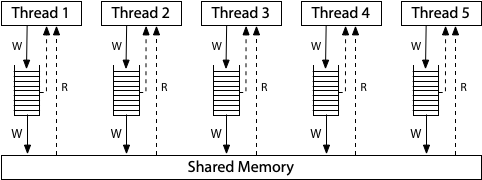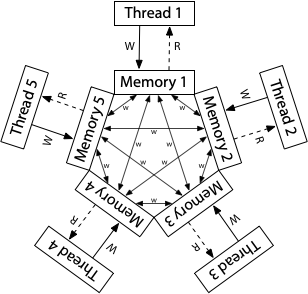C++ 中的内存序
C++ 中的内存序
cpp memory order
- Created: 2024-06-29T11:08+08:00
- Published: 2024-11-15T17:41+08:00
- Categories: C-CPP
单核访存模型
最早的时候,处理器只有单核(single core processor),编译器可以重排线程的代码,core 通过多发射同时执行多条指令。
比如同时执行两条 store 指令,其中一条的 store 可能更快地执行完。
这些指令重排与指令并行的优化对于单线程程序是有效的,因为它不影响程序的 output。
int a = x; int b = y; printf("a: %d\n", a); printf("b: %d\n", b);
比如上面的程序,汇编指令中 load a、load b 无论谁先完成都无所谓,只需要最后 printf 是按顺序的就好了。
单核处理器看起来就像每次执行一条指令,store 总是写入到 memory 后,才可以执行下一条指令。
多核访存模型 与 sequentially consistency
多核处理器时代就改变了这一切,最松散的内存模型如下:
- 一个 core 对内存的写入,其他 core 需要一段时间 load 才能读取到该值
- 一个 core 写入内存后,不同的 core 可能需要经过不同的时间后 load 才能读取到该值
这样的内存模型就非常松散,考虑下面的程序[1],
// program: if-done-print-x int x = 0, done = 0 // global // Thread 1 // Thread 2 x = 1; while(done == 0) { /* loop */ } done = 1; print(x);
t1 因为指令并行,导致内存中 done 写入 1,并且在极短的时间内,其他线程就得知了 done 被修改
t2 得知 done 为 1 后,就要读取 x,
此时 x=1 可能因为还在执行,所以 t2 print 0;
也可能 x=1 已经写入到内存,但是需要过很长的时间,才能被其他线程得知,所以 t2 还是 print 0
这就和程序员看到的代码不一样了,程序员本来希望有一种最严格的内存模型,符合如下规则:
- read、write、rmw(read-modify-write 如 CAS)都是原子性的,不可分割,
- 单线程内,所有的 read、write、rmw 都是顺序执行。后面的指令总是要等待前面的指令完成才可以执行
- 每次只能有一个线程访存
- 线程对内存的写入立刻对其他线程可见。比如 Thread A 执行 x=1 写入完成后,Thread B 读取 x 必然为 1,不需要任何等待。
Wikipedia 将其归结为 线程内部的指令是 sequence,以及 global 指令执行也是 sequence。
这样的话,就可以保证上述 if-done-print-x 程序总是可以 print 1。
x86-TSO(x86 Total Store Order)
本部分来自 https://research.swtch.com/hwmm#x86
作者写得非常清楚,可惜是英语,有些东西用中文表达起来本就拗口,用英文就更乱了。

x86-TSO 的内存模型约束如下:
- 每个 thread 的写入先写入一个自己的 write-queue
- 每个 thread 读取先查看自己的 write-queue,找不到就看内存
- 每个 thread 无法得知其他 thread 的 write-queue 内容
- 所有 thread 的 write queue 对 memory 的写入是 sequence 且 原子的。
none-sequential write-read
用 xyz 变量表示写内存,用 r1, r2 表示 thread 内部寄存器
下面测试展示了 TSO 和 sequentially consistent memory model 的区别:
Litmus Test: Write Queue (also called Store Buffer)
Can this program see r1 = 0, r2 = 0?
// Thread 1 // Thread 2 x = 1 y = 1 r1 = y r2 = x
On sequentially consistent hardware: no.
On x86 (or other TSO): yes!
对于先 write 后 read 指令,read 没法保证前面的 store 写入了内存,这导致 Dekker 互斥算法等其他算法失效。
所以需要 memory barrier 来保证 write-queue 被 flush 到内存上,就像:
x = 1 memory barrier r1 = y
total order
意思是,一个 core 写入内存后,立刻对其他所有 core 可见。
也就是说,core1 执行 x = 1 写入 memory 后,core2 执行 x=2,其他所有 core 都将观测到 先 x=1,然后 x=2,
不会观测到 先 x=2,后 x=1。
这叫做 coherence。
coherence 是对最松散的内存模型的一种约束,它要求不同 thread 的写入,在其他线程看来一定要有一个确定的顺序,否则很难编程。
ARM/POWER Relaxed Memory Model
参考 https://research.swtch.com/hwmm#relaxed

none-sequential write-write
Litmus Test: Message Passing
Can this program see r1 = 1, r2 = 0?
// Thread 1 // Thread 2 x = 1 r1 = y y = 1 r2 = x
On sequentially consistent hardware: no.
On x86 (or other TSO): no.
On ARM/POWER: yes!
ARM 架构中,x、y 的写入没有到 write-queue,而是直接到 cache,过一段时间其他线程才会看到,
x 和 y 传播到其他 cache 需要的时间是不同的(但是因为 coherence 要求,所有 thread 都会看到一个统一的写入顺序)
DRF
https://research.swtch.com/hwmm#drf
我的理解:
DRF 说,我们除了 read 和 write,再定义一种同步原语吧,
同步原语前的的 read 或者 write 一定完成,并且同步可以被不同的线程所知晓。



Acquire-Release 得名
In many multi-threaded algorithms, a thread writes some data and then writes to a flag that tells other threads that the data is ready.
This is known as a write-release.
If the writes are reordered, other threads may see that the flag is set before they can see the written data.Similarly, in many cases, a thread reads from a flag and then reads some shared data if the flag says that the thread has acquired access to the shared data.
This is known as a read-acquire.
If reads are reordered, then the data may be read from shared storage before the flag, and the values seen might not be up to date.https://learn.microsoft.com/en-us/windows/win32/dxtecharts/lockless-programming#reordering
所以我们需要两种机制:
- 保证一条 write 前的操作都执行完,再 write,
- 保证 read 先执行完,再执行 read 后面的指令
对于机制 1,就是前文提到的 memory barrier,将值 write 前的指令都 flush 到内存中
对于机制 2,就是防止 read 重排
C++11 的内存序
relax
relax:最松散的内存序,就是最松散的内存模型,只保证原子性写入,甚至不保证 coherence。
// Thread 1: r1 = y.load(std::memory_order_relaxed); // A x.store(r1, std::memory_order_relaxed); // B // Thread 2: r2 = x.load(std::memory_order_relaxed); // C y.store(42, std::memory_order_relaxed); // D
结果可能是 r1 = r2 = 42,因为 D 被重排到了 C 前面,执行顺序为 D->A->B->C
如果只有一条 atomic 操作,那 relax 内存序没啥用,
比如自增的 counter,用在 shared_ptr 中引用计数自增
// int x = 0; atomic_int x = 0; // the number added to x must be big enough to show data race // if the number is 10, thread1 executes so very fast that thread 2 even haven't been launched void add_1000000() { for (int i = 0; i < 1000000; ++i) { x += 1; } } int main() { thread th1(add_1000000); thread th2(add_1000000); th1.join(); th2.join(); std::cout << x << std::endl; // 2000000 or smaller if not atomic return 0; }
release/acquire/consume
release 保证前面的读写都完成,就像把 cache 中的值 flush 到内存中。
acquire 保证读取指令完成后,再执行后面的指令,release-acquire 就构成了 synchronize-with。
Synchronizes with
If an atomic store in thread A is a release operation,
an atomic load in thread B from the same variable is an acquire operation,
and the load in thread B reads a value written by the store in thread A,
then the store in thread A synchronizes-with the load in thread B.Also, some library calls may be defined to synchronize-with other library calls on other threads.
std::memory_order - cppreference.com
consume 较于 acquire 更加松散,只禁止后面依赖于其 load 的值的指令重排到其前面。
acq-rel
给 RMW 用的,比如 atomic_int.fetch_add(int val),既充当 release,也充当 acquire。
seq-cst
A load operation with this memory order performs an acquire operation,
a store performs a release operation,
and read-modify-write performs both an acquire operation and a release operation,
plus a single total order exists in which all threads observe all modifications in the same order (see Sequentially-consistent ordering below).
std::memory_order - cppreference.com
最严格的内存模型,禁止周围指令重排,我觉得最后一句话没有必要,如果不这么做,就违背了 coherence。
不过 cpp reference 自己形式化定义了所有的名词,所以可能在它的语境下,最后一句话是有必要的。
volatile 不能保证多线程的同步
Item 40:对于并发使用 std::atomic,volatile 用于特殊内存区 - Effective Modern C++
volatile 应该用于 special 内存。
volatile 看起来好像可以实现线程之间的同步:
int x = 0; /* volatile */ int flag = 0; // whether x has been written void thread1_write_x() { x = 100; flag = 1; } void thread2_read_x() { while (flag == 0) ; // spin // we want to see x equals 100, but it may: // 1. x equals 0 because of the reorder for write_x // 2. never execute to this line because of the optimization std::cout << x << std::endl; } int main() { thread t2(thread2_read_x); thread t1(thread1_write_x); t1.join(); t2.join(); return 0; }
如果不使用 volatile,spin 那一行代码可能会被优化为只读取一次到寄存器里,导致 thread2 一直 spin:
load r0 flag while (not r0) ;
使用了 volatile,每一次 read flag 都会重新从内存中读取一遍,编译器不会将多次 read 优化为一次:
READ: load r0 flag while (not r0) goto READ
所以 volatile 看起来实现了两个线程间的同步,但是并不能实现原子性,因为 thread1 可能由于编译器重排或者 CPU 乱序执行导致 flag=1 先于 x=100:
实际执行顺序:
flag = 1 x = 100
如果您有任何关于文章的建议,欢迎评论或在 GitHub 提 PR
作者:dutrmp19
本文为作者原创,转载请在 文章开头 注明出处:https://www.cnblogs.com/dutrmp19/p/18548384
遵循 CC 4.0 BY-SA 版权协议








【推荐】国内首个AI IDE,深度理解中文开发场景,立即下载体验Trae
【推荐】编程新体验,更懂你的AI,立即体验豆包MarsCode编程助手
【推荐】抖音旗下AI助手豆包,你的智能百科全书,全免费不限次数
【推荐】轻量又高性能的 SSH 工具 IShell:AI 加持,快人一步
· 被坑几百块钱后,我竟然真的恢复了删除的微信聊天记录!
· 【自荐】一款简洁、开源的在线白板工具 Drawnix
· 没有Manus邀请码?试试免邀请码的MGX或者开源的OpenManus吧
· 园子的第一款AI主题卫衣上架——"HELLO! HOW CAN I ASSIST YOU TODAY
· 无需6万激活码!GitHub神秘组织3小时极速复刻Manus,手把手教你使用OpenManus搭建本
2021-11-15 vue中无法使用slice, split
2021-11-15 el-carousel中放图片